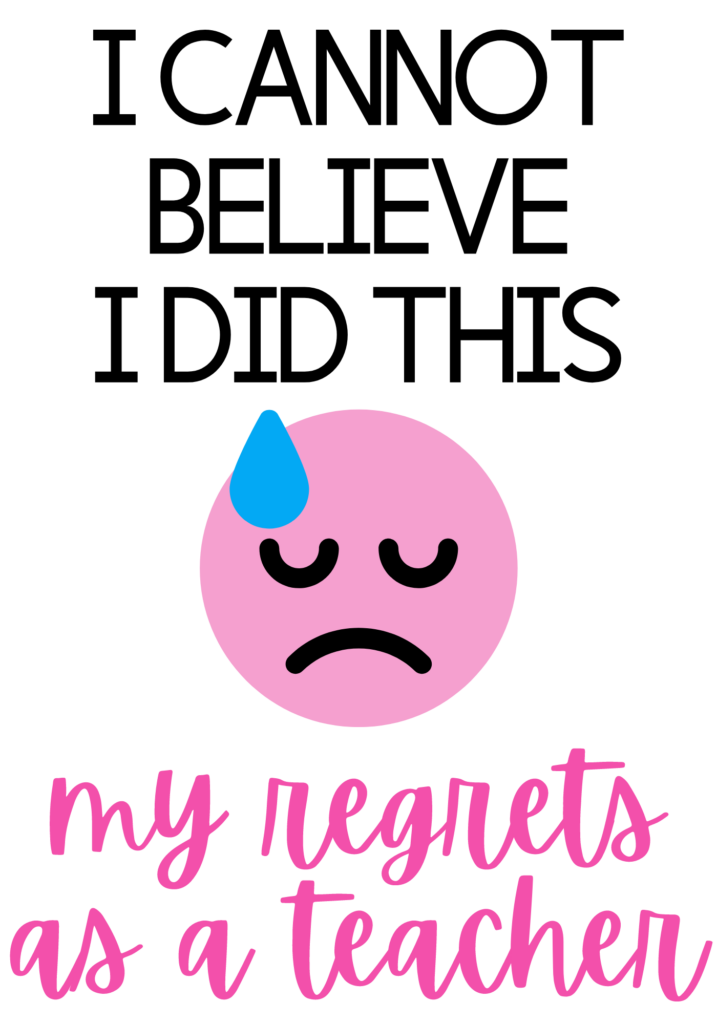Things I Wish I Hadn’t Done in the Classroom
Hi teacher! Today this post is for you! Usually I write for teachers and grown ups with kids at home. Lately, I’ve been doing lots of reflection as I think about my daughter entering kindergarten in a few years. I have learned so much about child development and psychology, worked on some of my own trauma, and I am a totally different person than when I started teaching 13 years ago.
Looking back, I was probably one of the “gentlest” teachers on my campus. I really, really did try to foster strong relationships, create an emotionally safe classroom environment, and I still really missed the mark. I hope that I can share some of my mistakes, so that you don’t have to make the same ones. Our students deserve to feel respected, heard and safe when they enter our rooms. These are things I did, because I didn’t know any better. But now we know better, so we do better.
Not Allowing Free Bathroom Breaks
One of the things I heard over and over from students and teachers was how nice it was to be able to use the bathroom whenever they wanted during virtual learning. At both campuses I worked at, we had community bathrooms in the hallway. I felt like bathroom breaks were a waste of our classroom time, and they were pretty hard to manage. But, I also didn’t allow my students to go whenever they needed. I was worried they were using it to escape (I’ll get to that in a minute), or just wanted to play. I think at one point I tried potty tokens, or some sort of way to allow so many breaks per day. I know the management of this can be really hard, and there is lots of admin pressure about not having students in the hallway. But I do think there has to be a way to give students bodily autonomy, and keep everyone safe. I think that the more ownership we give students in their learning, the more they will “rise to the occasion.”
Class Dojo and Clip Charts
To be honest, this one makes my stomach hurt. I am so ashamed that I ever used these in my classroom. I’ve shared about Clip Charts since then, and I hope that they are becoming more rare in classrooms. I thought I was really progressive when I started using Class Dojo, because they could earn positive points. I don’t think I really used it to take points away often. But it was still a currency tied to behavior, and I understand now how unfair that is. I tried really hard to give all of my students points, and I even made a post about using it to give points to al of my students. I still had students though who rarely got to cash their points out. Most importantly, though, I think it made students feel that their worth to me (and their classmates) was tied to how well they could stay in their seats, not shout out, or follow directions. It’s even more upsetting to me, because so many of my students had high support needs. They NEEDED behavior supports, because it was hard for them. I wasn’t really teaching them how to be successful…I was just making them feel less successful than their neurotypical peers.
Discouraging Stims
This one also truly makes me feel sick to my stomach. My first year teaching, I taught a 3rd grade class. I had two precious boys who came in my room everyday for their inclusion time. One of them, let’s call him Jose, stimmed a lot. He had pretty high support needs, and I imagine coming into my room was anxiety inducing for him. He “flapped” his hands a lot, and his teachers told me they were trying to get him to stop. We encouraged him to keep his hands in his pockets so that he wouldn’t stim with his hands. I hate, hate, hate that I ever did this to him. I know that I was kind about it, and I didn’t know it was hurtful. But looking back, I am devastated I was taking away one of his main coping mechanisms. Because I have ADHD, anxiety, and depression, I use a lot of coping skills to get through the day. I bounce my leg, listen to white noise or music, do breathing exercises, and go to therapy alot. Imagine if someone told me I couldn’t do those anymore…at a time of my day that was most stressful. Please, please don’t do this.
Public Reminders
Looking back, I really tried not to publicly correct my students. But I think that I just didn’t yell at them…or get really frustrated. I still said their name A LOT. I still reminded them A LOT what I expected of them. Did you know that students with ADHD receive exponentially more negative feedback than their neurotypical peers? I wish that I had made eye contact with them, gently tapped their shoulders, or honestly, just not addressed it at all unless I could chat with them completely privately.
Expecting Perfection in the Hallway
A lot of the things on this list I did because everyone else did. My admins expected my studnets to walk SILENTLY down the hallway, IN A LINE, ON THE SECOND WHITE SQUARE. I’m using all caps, because that’s how it feels when I think about it. Now that we know so much more about different students’ sensory needs, I wish I had used the hallway as a movement break. I understand that classes around us need quiet…so I’m not saying let student yell, sing, or even chat loudly as they walk down the hallway. What I am saying is that if a student gets the stimulation they need by hopping, they will be MORE successful when we come back to the room if I let them do that. Would it really impact anyone if I let them march, hop, skip or walk on the other side of the hallway? For some kids, standing in a line is really, really hard. Was it worth me damaging our relationship and giving them more negative feedback for them to walk on the right side of the hallway? No, I definitely don’t think so.
Making Students Earn Breaks
Honestly, when I stared teaching, I hadn’t even heard of giving breaks. So offering that at all felt pretty progressive. But many of my students NEEDED those breaks. They would have been so much more successful if they were a structured, regular, predictable part of their routine. When our students are getting over stimulated or frustrated, pushing them to “earn” their break will usually make things a lot worse. If a child needs a break, they need it no matter what.
I’m sure I could come back to this list over and and over an add to it. There are a million things I wish I could go back and redo, and things I hope my daughter and her friends never have to deal with. I know that the pressures of teaching are out of control, but I also know we have the opportunity to keep students from experience trauma at the hands of teachers who think they’re doing what’s best.

